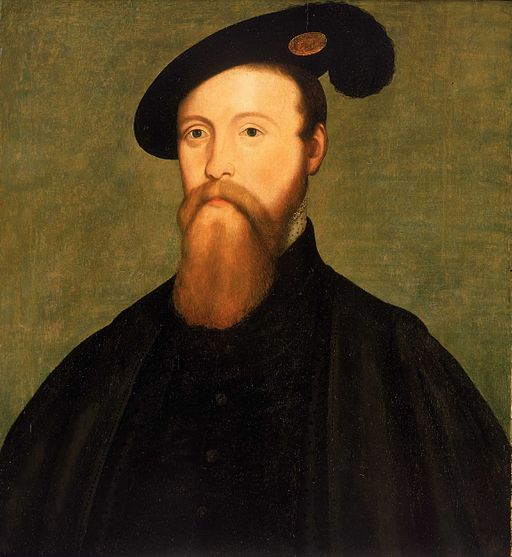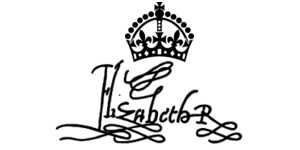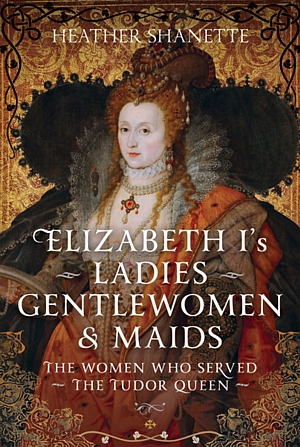
Queen Elizabeth I
Troubled Teens
Following the death of her father, King Henry VIII, in the January of 1547, Elizabeth went to live with her stepmother,
Kateryn Parr, now her guardian. This should have been a happy and nurturing environment for Elizabeth, who was only
thirteen years of age, but Kateryn Parr made a rather foolish decision that spring when she married her former
sweetheart, Thomas Seymour, Lord Admiral, King Edward's uncle and brother of Edward Seymour, Lord Protector of England. For a while
the couple kept their relationship a secret, as Kateryn was still in formal mourning for the King, but by the summer the admiral had
moved in with Kateryn. This began a very difficult few years for Elizabeth as the admiral, who was a rash and impetuous man, took an
inappropriate interest in her. He liked to flirt with Elizabeth, even though he was her guardian, and began to visit her bedchamber in the
mornings to 'bid her good morrow' with inappropriate gestures like a slap on the bottom. Elizabeth's governess, Mistress Astley, complained
to the Queen Dowager about the admiral's behaviour, but Kateryn Parr was not concerned, believing it was all just harmless fun. She even started
accompanying the admiral to Elizabeth's bedchamber and sometimes they would both tickle her in her bed.
Elizabeth's governess remained unhappy about the early morning visits but was helpless to resolve
the situation as long as the Queen Dowager was unconcerned. Eventually, however, Kateryn Parr became jealous of her husband's interest in
Elizabeth and began to suspect they were having an affair. This is extremely unlikely as there was no opportunity
for Seymour to be alone with Elizabeth. Her governess slept in Elizabeth's bed every night, to make sure the young royal was
safe from the admiral's advances, and Elizabeth was constantly surrounded by her gentlewomen and maids.

Thomas Seymour
Matters came to a head when Kateryn Parr became pregnant. The Queen Dowager believed that it was better for everyone if
Elizabeth left the household. So Elizabeth and her attendants went to stay with Sir Edmund and Lady Denny for a while, these being her governess's close family, and eventually she returned
to Hatfield Palace in Hertfordshire. In the autumn of that year, which was 1548, Kateryn Parr gave birth to a baby girl at Sudeley Castle, but sadly she died
a few days later from infection. Her baby girl lived for at least two years but then disappears from history.
Unfortunately for Elizabeth, leaving the Queen Dowager's household was not the end of her troubles with the admiral. Shortly
after his wife's death Seymour was accused of treason. He was accused of trying to seize power by secretly marrying Elizabeth and
by kidnapping the King. Whether these accusations are true is unclear, but Seymour's arrest for treason landed Elizabeth and
her governess in deep trouble. It was said that Mistress Astley had colluded with the admiral to bring about a
secret marriage between him and Elizabeth. It was treason for an heir to the throne to marry without the consent of the King and his Privy Council so
Mistress Astley was arrested and sent to the Tower of London. Elizabeth herself was placed under house arrest and
rigorously interrogated by Sir Robert Tyrwhit. One careless word could spell her death, and that of her governess, but Elizabeth
outwitted Sir Robert and managed to uphold her innocence. The admiral, however, was found guilty of high treason and
condemned to death.
All the weeks and months of worry took their toll on Elizabeth's health, and for some time she was very ill, but by the summer of 1549 things
were looking up. Mistress Astley was back at her side and her reputation, which had been badly tarnished, was recovering. That Christmas she
was invited to court for the first time since the scandal and Elizabeth did all that she could to show the
world that she was a virtuous young lady. She dressed modestly, behaved piously, and studied hard. Indeed, her sobriety
was such that King Edward called her "sweet sister temperance".

John Dudley
The Lord Protector, Edward Seymour, was disgraced by the treason of his brother and was soon
replaced by John Dudley, Earl of Warwick, soon to be Duke of Northumberland. By now Elizabeth was an adult and responsible for
her own affairs. She was very wealthy, as she had been left thousands of pounds by her father, and one of the first things she did when she
came into her inheritance was to buy her favourite childhood home, Hatfield Palace in Hertfordshire,
and make it her principal residence.
John Dudley ruled England in Edward's name for three years, but in 1553 the young King's health took a
turn for the worst and he died that summer. This plunged the country into crisis as the heir to the throne
was his half-sister, Mary, who had been restored
to the line of succession, along with Elizabeth, by King Henry in an Act of Parliament. Mary was a Catholic
and John Dudley, along with the King's advisors, knew that
she would restore the 'old faith' in the land.
In the hope of preventing Mary's accession, John Dudley and the King's advisors changed the order of succession. They excluded
Mary and Elizabeth, on the grounds they were both illegitimate, and settled the crown
on King Henry's great niece, Lady Jane Grey. In the weeks running up to the King's death, John Dudley married his
youngest son, Guildford Dudley, to Jane, to bolster his own position, and after the King's passing declared that Lady Jane was the next
rightful queen.
The news that Lady Jane was now queen was met with shock all over London. No one had expected this. Mary was popular
with the people, just as her mother had been, and most people cared little for the 'new religion'. Mary was able to raise an army to
fight Lady Jane and the duke for the throne and within days she was victorious.
Following the death of her father, King Henry VIII, in the January of 1547, Elizabeth went to live with her stepmother,
Kateryn Parr, now her guardian. This should have been a happy and nurturing environment for Elizabeth, who was only
thirteen years of age, but Kateryn Parr made a rather foolish decision that spring when she married her former
sweetheart, Thomas Seymour, Lord Admiral, King Edward's uncle and brother of Edward Seymour, Lord Protector of England. For a while
the couple kept their relationship a secret, as Kateryn was still in formal mourning for the King, but by the summer the admiral had
moved in with Kateryn. This began a very difficult few years for Elizabeth as the admiral, who was a rash and impetuous man, took an
inappropriate interest in her. He liked to flirt with Elizabeth, even though he was her guardian, and began to visit her bedchamber in the
mornings to 'bid her good morrow' with inappropriate gestures like a slap on the bottom. Elizabeth's governess, Mistress Astley, complained
to the Queen Dowager about the admiral's behaviour, but Kateryn Parr was not concerned, believing it was all just harmless fun. She even started
accompanying the admiral to Elizabeth's bedchamber and sometimes they would both tickle her in her bed.
Elizabeth's governess remained unhappy about the early morning visits but was helpless to resolve
the situation as long as the Queen Dowager was unconcerned. Eventually, however, Kateryn Parr became jealous of her husband's interest in
Elizabeth and began to suspect they were having an affair. This is extremely unlikely as there was no opportunity
for Seymour to be alone with Elizabeth. Her governess slept in Elizabeth's bed every night, to make sure the young royal was
safe from the admiral's advances, and Elizabeth was constantly surrounded by her gentlewomen and maids.

Thomas Seymour
Matters came to a head when Kateryn Parr became pregnant. The Queen Dowager believed that it was better for everyone if
Elizabeth left the household. So Elizabeth and her attendants went to stay with Sir Edmund and Lady Denny for a while, these being her governess's close family, and eventually she returned
to Hatfield Palace in Hertfordshire. In the autumn of that year, which was 1548, Kateryn Parr gave birth to a baby girl at Sudeley Castle, but sadly she died
a few days later from infection. Her baby girl lived for at least two years but then disappears from history.
Unfortunately for Elizabeth, leaving the Queen Dowager's household was not the end of her troubles with the admiral. Shortly
after his wife's death Seymour was accused of treason. He was accused of trying to seize power by secretly marrying Elizabeth and
by kidnapping the King. Whether these accusations are true is unclear, but Seymour's arrest for treason landed Elizabeth and
her governess in deep trouble. It was said that Mistress Astley had colluded with the admiral to bring about a
secret marriage between him and Elizabeth. It was treason for an heir to the throne to marry without the consent of the King and his Privy Council so
Mistress Astley was arrested and sent to the Tower of London. Elizabeth herself was placed under house arrest and
rigorously interrogated by Sir Robert Tyrwhit. One careless word could spell her death, and that of her governess, but Elizabeth
outwitted Sir Robert and managed to uphold her innocence. The admiral, however, was found guilty of high treason and
condemned to death.
All the weeks and months of worry took their toll on Elizabeth's health, and for some time she was very ill, but by the summer of 1549 things
were looking up. Mistress Astley was back at her side and her reputation, which had been badly tarnished, was recovering. That Christmas she
was invited to court for the first time since the scandal and Elizabeth did all that she could to show the
world that she was a virtuous young lady. She dressed modestly, behaved piously, and studied hard. Indeed, her sobriety
was such that King Edward called her "sweet sister temperance".

John Dudley
The Lord Protector, Edward Seymour, was disgraced by the treason of his brother and was soon
replaced by John Dudley, Earl of Warwick, soon to be Duke of Northumberland. By now Elizabeth was an adult and responsible for
her own affairs. She was very wealthy, as she had been left thousands of pounds by her father, and one of the first things she did when she
came into her inheritance was to buy her favourite childhood home, Hatfield Palace in Hertfordshire,
and make it her principal residence.
John Dudley ruled England in Edward's name for three years, but in 1553 the young King's health took a
turn for the worst and he died that summer. This plunged the country into crisis as the heir to the throne
was his half-sister, Mary, who had been restored
to the line of succession, along with Elizabeth, by King Henry in an Act of Parliament. Mary was a Catholic
and John Dudley, along with the King's advisors, knew that
she would restore the 'old faith' in the land.
In the hope of preventing Mary's accession, John Dudley and the King's advisors changed the order of succession. They excluded
Mary and Elizabeth, on the grounds they were both illegitimate, and settled the crown
on King Henry's great niece, Lady Jane Grey. In the weeks running up to the King's death, John Dudley married his
youngest son, Guildford Dudley, to Jane, to bolster his own position, and after the King's passing declared that Lady Jane was the next
rightful queen.
The news that Lady Jane was now queen was met with shock all over London. No one had expected this. Mary was popular
with the people, just as her mother had been, and most people cared little for the 'new religion'. Mary was able to raise an army to
fight Lady Jane and the duke for the throne and within days she was victorious.





























